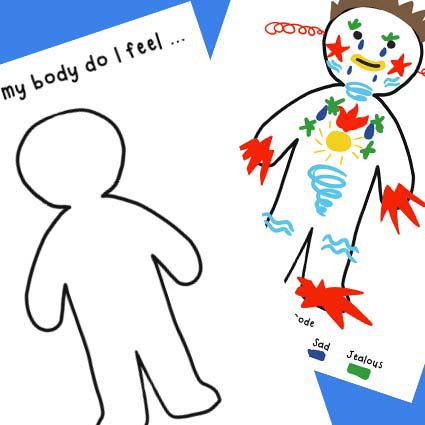3 Tips To Help Your Child Name Their Emotions

Emotions can be confusing to children and identifying them becomes more difficult when they do not have the language to articulate them.
In this article there are 3 tips to help you teach your child how to begin to identify & name their emotions.
At the bottom of the article is a free printable for you to download and use with your child as a fun exercise to support you in helping them learn to identify their emotions InShaAllah.

- Discuss Emotions With Your Child
Discussing emotions and feelings with your child and making them a part of regular conversations is a really effective way to help your child learn about their own emotions. Look out for every day experiences or ‘teachable movements’ to explore with you child a range of different emotions.
For example you could say something like:
Grandpa looked really happy when you gave him that present ….. how do we know he was happy?
Can you think of a time when you were angry? What does it feel like when you’re angry, what do you feel like doing when you’re angry? How do we know when someone else is angry?
Another effective way is to read Islamic stories and stories from the Quran and ask your child questions e.g. how do you think the Prophet (saws) felt when those people threw rubbish on him and were mean to him; how do you think Imam Ali Ibn Abu Talib (as) felt when that man spat in his face? How would you feel if someone did that to you? With older children you don’t necessarily need to read stories if they consider themselves too old for this, but you can discuss Islamic events with them, or events that are relayed within the Quran. Maybe even get them to draw a cartoon strip or make an ezine of an Islamic event and to reflect on the emotions felt by those involved.
2. Validate Your Child’s Emotion
Validating your child’s emotions is essential in helping them to regulate their own feelings both as a child and into adulthood. Often in our cultures emotions are unwittingly invalidated e.g. boys don’t cry, nice girls don’t get angry; pull your socks up and get over it; your pet died … it doesn’t matter it was only a hamster. Such sayings teach the child that it is not ok to feel what they are feeling and this can lead to them internalising this belief and then invalidating their own feelings which can cause various emotional problems throughout life.
It is therefore important to always validate your child’s emotion, even if you don’t think they should be feeling like that. Remember all emotions are valid!
Examples of how you may validate an emotion:
I can see you’re sad that you didn’t win the competition (rather than … It doesn’t matter theres always next time)
I understand you’re frustrated because your toy broke (rather than …. Well it’s your fault, you broke it)
I can see you’re really upset and anxious and don’t want to go to school, it must feel very frightening (rather than … well I hated school and I had to go; you’ll like it once you’re there, you have to go coz I’ve got work to do)
Validating the emotion does not mean agreeing with any unwanted behaviour but it helps your child learn how to label their feelings and lets them know their feelings have been seen/heard and that having feelings is acceptable. The behavioural response to the feeling may then need managing but the existence of feelings in and of themselves needs to be validated in order to help you child learn to regulate them.


3. Explore How Emotions Feel In The Body
Emotions have associated sensory reactions in the body and thus they are felt rather than thought. A person who is anxious often describes a thumping heart, sweaty hands, dry mouth and so on. Helping your child identify the physical changes in their body when they feel a certain emotion is a great way of helping them further identify and name there emotions.
If you child needs support then you can make observations e.g. I notice your hands clench and your face goes red when you’re angry. Work on one emotion at a time to help your child identify the physical sensations they feel with that emotion. You can also look at photos or images of people (whole body not just face) displaying certain emotions and ask your child to describe what they see or ask them how do they know that person is sad/scared/angry etc from just looking at them.
Below you can download our free printable and fun exercise to help your child identify their body sensations, and if you’d like to receive regular free resources then just subscribe to our email list.
N.B. Warning do not try and discuss emotions with your child if they are in the midst of a tantrum or if you yourself are tired or stressed. It is only truly effective when you are both calm.

